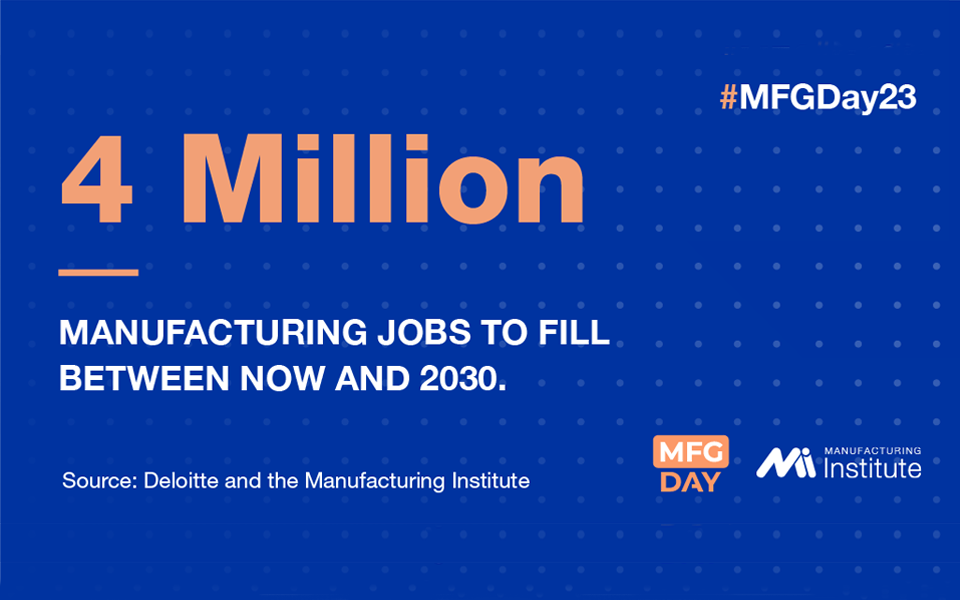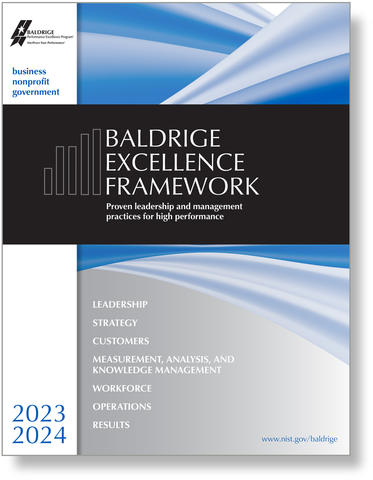Blogrige
The Official Baldrige Blog

During the recent celebration of Manufacturing Day, thousands of U.S. manufacturers showcased the realities of modern manufacturing to students as a way to inspire the next generation.
The importance of this cannot be understated, as over the next decade, 4 million U.S. manufacturing jobs will need to be filled, according to a workforce study by The Manufacturing Institute and Deloitte. The study reports that a skills gap may leave more than half of those manufacturing jobs unfilled through 2028, creating $2.5 trillion of unrealized economic impact.
Through its products and services to inspire quality jobs and ensure long-term success, the Baldrige Performance Excellence Program (BPEP), part of the National Institute of Standards and Technology (NIST), is supporting the resilience of both U.S. manufacturing and the education organizations among its community who are nurturing the skilled workforce of the next generation. Through a series of articles, BPEP plans to highlight these education organizations and modern manufacturing.
Possible Pathways to Manufacturing Careers
I had an opportunity to interview Joe Sprangel, principal consultant, Emmanuel Strategic Sustainability, who was the founding dean of the College of Business and Professional Studies at Mary Baldwin University and who recently returned to his associate professor role. Sprangel also serves as a volunteer examiner for the United States Senate Productivity and Quality Award (SPQA), the Baldrige-based Alliance for Performance Excellence program in the state of Virginia.
In his book Humanist Manufacturing: A Humanitarian Approach to Excellence in High-Impact Plant Operations, Sprangel recommends that manufacturing executive teams would benefit from using the Baldrige Excellence Framework® and, in particular, the Baldrige assessment factors of approach, deployment, learning, and integration (ADLI) to fully develop strategies (some suggested below) and a holistic project plan to develop their workforces.
Based on his own personal experiences, Sprangel offered commentary on ways to enhance careers in U.S. manufacturing to make it more resilient to the skills gap.
A Pin-Striped Career
After high school, Sprangel said, he bounced around in various jobs until he began one that led to an industrial machine repair apprenticeship. “The apprenticeship combined work in manufacturing plants during the day and trades-level coursework at the local community college in the evenings,” he said. “A geometry instructor ignited my desire to learn, leading me to earn four different degrees up to a doctorate. I also leveraged the machine repair work into ongoing promotions over 30 years in manufacturing, progressing into white-collar engineering and plant management roles. I then joke that I had a mid-life crisis where I became a professor and a university dean for the last 16 years.”
A common question early on for high school students, Sprangel said, is whether they will follow a blue- or white-collar career path. “While both choices have great merits, I offer an alternative--a pinstriped collar approach based on my career . . . where individuals merge the best of the blue and white collars instead of an either-or choice.”
According to Sprangel, in a blue-collar job that required manual work, he
- acquired a deep appreciation of the value of shop-floor peers,
- learned skills typically found in manufacturing that translated well to his success in white-collar work,
- developed strong problem-solving and project management skills,
- gained a deep understanding of the opportunities and challenges faced by those in blue-collar jobs,
- found a pathway to ongoing promotions,
- earned substantial manufacturing pay that led to a more robust base salary when negotiating later job offers, and
- worked for manufacturing employers that provided tuition reimbursement.
Said Sprangel, in his white-collar office work, he
- was able to show proper gratitude to those working at all levels of the organization,
- acquired quicker credibility with those in blue-collar jobs,
- had a strong understanding of the value of those doing the blue-collar work,
- could solve issues using a more comprehensive range of stakeholder perspectives,
- brought to the managerial team an ability to break complex projects down to the smallest of incremental tasks,
- continued to be promoted due to extensive knowledge of plant operations, and
- ended up with almost zero student debt after earning four degrees, including a doctorate.
Adopting the Military Recruiter Model
The military faces a similar issue to the manufacturing industry in terms of a declining percentage of individuals interested in beginning their adult life in military service, Sprangel said. The recruiter role used by the military is to entice individuals to join the military by providing information regarding training and career opportunities available in the five service branches.
Sprangel said he thinks that the manufacturing industry could use a similar model. An area industry recruiter could receive financial support from a collective of manufacturing plants, nonprofits, or government funding to target traditional and alternative hiring pools. The manufacturing recruiter would work with the key players in the community. He/she could attend job and career fairs to meet potential employees. He/she could also develop relationships with local high schools to provide further insight regarding the value of manufacturing careers for students. The recruiter could also be the point person to gain community involvement in integrating various groups into the manufacturing workforce, said Sprangel, adding that the first step is to determine the wisdom leaders in the community.
Breaking the Poverty Cycle
Those currently facing financial challenges could be some of the potential employees to close the growing employment gap in manufacturing while providing an opportunity for them to "thrive and grow to their capabilities," Sprangel said; “Suppose a single young adult makes the poverty line salary of $13,590, and the average entry-level manufacturing salary . . . is $31,001. In that case, there is an opportunity to double their income. Then, they can utilize tuition assistance and other employer support to reach an average 2019 manufacturing salary of nearly $84,000.”
Given the difficulty in hiring enough employees to fill open manufacturing jobs, the issue is not the availability of work, said Sprangel. Instead, potential employees face the problems of (1) affordable childcare; (2) a lack of education, training, and experience; (3) high transportation costs; (4) low English-speaking proficiency; (5) a lack of access to fundamental worker rights; (6) discrimination of those with a criminal record; and (7) lack of proper documentation.
Those currently in poverty likely are from multiple generations of this economic state. Unfortunately, structural barriers make it difficult for children from families facing this challenge to break the poverty cycle, said Sprangel, citing the Annie E. Casey Foundation's Family-Centered Community Change (FCCC), which developed a two-generation approach where participants worked with local families with children ten or younger to make recommendations of breaking the poverty cycle. The recommendations include ensuring inclusion of those who have been historically disenfranchised in developing wealth-building and stability improvement strategies, engaging partners at multiple levels to develop creative opportunities, measuring impact, and responding proactively to new challenges to lessen social and economic harms.
Baldrige Supports the Resilience of Manufacturing
Aligned with its mission to improve the performance of U.S. organizations, BPEP is revising its Baldrige Award process, to be rolled out in 2024, to recognize U.S. role models of resilience and long-term success. Part of that recognition includes fostering the sharing and adoption of proven practices, including workforce practices, and providing products, services, and insights to help manufacturers and other organizations prepare, adapt, innovate, and thrive through skills gaps and disruptions.
For example, BPEP led the effort to develop a Job Quality Toolkit, a menu of vetted strategies and actions for leaders and their workforces to collaboratively choose from to increase the quality of jobs offered. The toolkit focuses on eight drivers of job quality, as well as examples of how Baldrige Award recipients demonstrate those strategies and actions.
In addition, to help U.S. manufacturers ensure that they have the systems and processes in place to implement the latest advanced technologies and improve their quality of operations, a project team created an assessment and accompanying resources based on The Baldrige Excellence Framework®.
The Baldrige framework remains BPEP’s flagship product, which can be used for measuring performance and planning in an uncertain environment. A manufacturer can use the Baldrige framework to organize and integrate approaches (e.g., ISO 9000, Lean, and Six Sigma), and improve productivity and effectiveness.

Baldrige Excellence Framework®
The Baldrige Excellence Framework® has empowered organizations to accomplish their missions, improve results, and become more competitive. It includes the Criteria for Performance Excellence®, core values and concepts, and guidelines for evaluating your processes and results.
Purchase your copy today!
Available versions: Business/Nonprofit, Education, and Health Care





